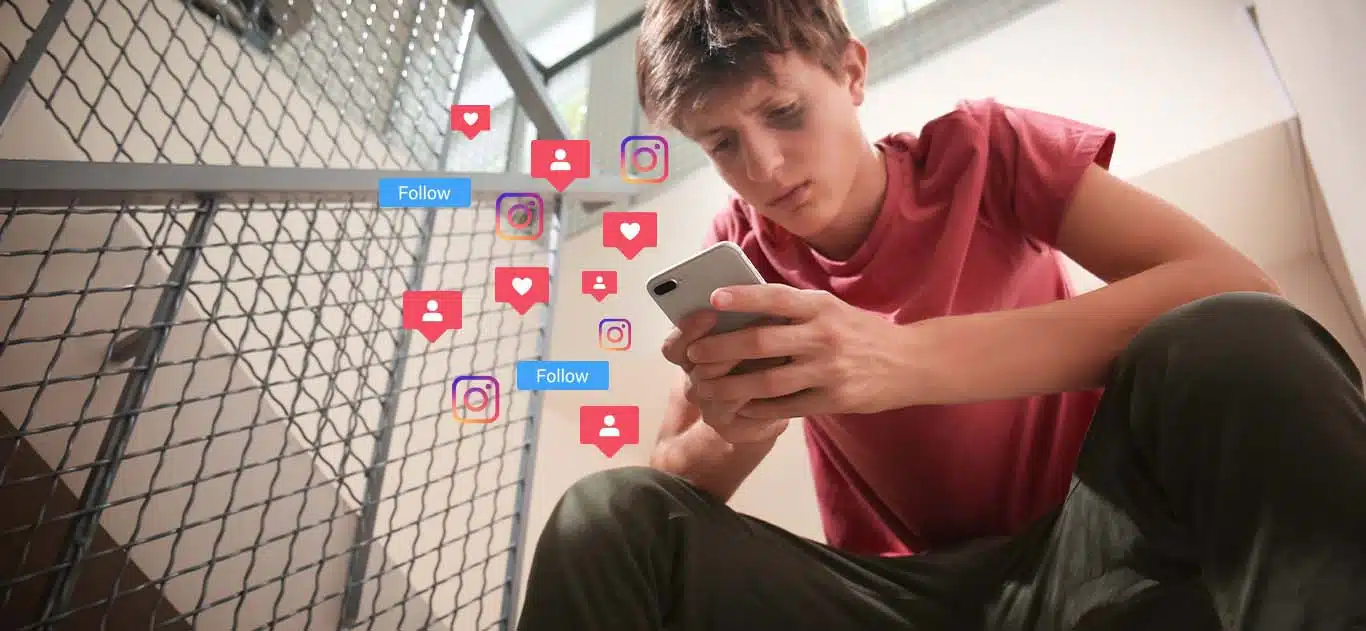With the vast majority of teens spending hours upon hours of time in the online world, teen cyberbullying has become rampant. Social media and other online forums provide ways for teens to bully peers without real-life repercussions. Less online supervision and increased stress among this age group have also contributed to high rates of teenage cyberbullying.
Even without a physical component, cyberbullying has a significant negative impact on teens. It causes distress and can exacerbate symptoms of teen anxiety, teen depression, and teen isolation. Moreover, victims of cyberbullying are four times as likely to engage in suicidal thoughts or attempts.
Key Takeaways
- About half of all US teens (ages 13–17) have been bullied or harassed online.
- Adolescents who experience cyberbullying experience higher rates of depression, anxiety, loneliness, and suicidal behavior.
- Parents can educate their teens and use online safety features to combat cyberbullying.
- For teens who have been bullied online, mental health treatment may be necessary.
What is Teen Cyberbullying?
Teenage bullying is when a bully uses physical strength or social influence to intimidate a perceived weaker person. Teenage cyberbullying involves the same patterns of intimidation but takes place where young people interact online: digital devices, such as cellphones and computers, and online interactions on social media and gaming platforms. An online environment intended to create connection can turn into a dangerous and negative space for teens.
Cyberbullying typically takes the form of a teen sending or posting harmful or false content about a peer, or sharing another teen’s personal or private information, with the goal of causing embarrassment or humiliation. For example, a cyberbully might share an awkward picture of another teen, or a post taken out of context.
TikTok cyberbullying usually takes the form of sharing a humiliating video, or making mean comments on other users’ videos. Cyberbullying can also include being called offensive names online. In addition to the social media sites people use most frequently, online bullying also takes place via instant messaging apps or text messages between young people.
Teen Cyberbullying Statistics 2023
A new report from the Pew Research Center found that 46 percent of US teens (ages 13–17) have been bullied or harassed online. Teens in the survey reported on distinct types of cyberbullying they had experienced. The report found that different age groups and ethnic groups had slightly different cyberbullying experiences.
Both older and younger teens reported being the target of name-calling or rumor spreading. However, older teens were twice as likely than younger teens to have been sent explicit images they didn’t ask for, a type of online bullying referred to as cyberflashing. Older teens were also twice as likely to have had someone share explicit images of them without their consent (also known as “revenge porn”). Furthermore, Black teens were about twice as likely as Hispanic or White teens to have been bullied online due to their race or ethnicity.
One third
off teens have been called an offensive name online or on their cellphone
31%
of teens who have personally experienced online harassment or bullying think they were targeted because of their physical appearance
1 in 10
have been physically threatened online
7%
have had explicit images of them shared without their consent, either on social media or via text messaging
1 in 4
teens have had false rumors spread about them online
28%
of teens have experienced multiple types of cyberbullying
The Mental Health Effects of Cyberbullying
Online harassment does significant psychological and emotional damage. Research shows that adolescents who experience cyberbullying are more likely to suffer from depression, anxiety, loneliness, suicidal behavior, and physical symptoms triggered by mental health issues. Moreover, young people who perpetrate cyberbullying have higher rates of substance use, aggression, and delinquent behaviors.
Here are some recent statistics on the mental health impacts of cyberbullying on teens.
- Teen cyberbullying victims are four times as likely to engage in self-harming or suicidal behavior vs. those who were not cyberbullied.
- In one study, 93 percent of cyberbullying victims reported negative mental health effects, primarily feelings of sadness and hopelessness.
- Two-thirds of students who experienced teenage cyberbullying say that it “really affected their ability to learn and feel safe at school.”
- One-third of all cyberbullying victims experience at least one symptom of stress.
- 66 percent of female victims have feelings of powerlessness because of cyberbullying.
- Both targets and perpetrators of online harassment are more likely to have low self-esteem.
Furthermore, researchers have found that being a victim of cyberbullying has a more negative effect on adolescents’ social and emotional well-being than traditional bullying. Given these disturbing statistics on teenage cyberbullying, parents, teens, school administrators, and policymakers need to work together to end online harassment.
Where Does Teen Cyberbullying Happen?
Unlike face-to-face teenage bullying, cyberbullying creates a sense of distance—in both time and space—between bullies and their victims. This gap gives bullies the illusion of anonymity, and thus increases a tendency toward even harsher harassment. Places where cyberbullying occurs among teens include the following:
- Social media platforms like TikTok, Facebook, Twitter, Instagram, Snapchat, and YOLO (a question-and-answer app that teen cyberbullies use to shame and embarrass vulnerable adolescents, by asking hurtful questions about them)
- Text messaging on cell phones and other devices, including both one-on-one messages and group messaging
- Gaming forums or during online video game playing, where teens play gaming characters in multiplayer formats.
- Instant messages delivered via social media messaging features, smartphone apps, and other messaging services
- Anonymous messaging apps and sites like Kik, Sarahah, and Askfm, which allow for messages and feedback without identifying the source
- Email, although this is less common since teens now see email as being somewhat old-fashioned.
To combat cyberbullying and other abusive online behaviors, some platforms have developed stricter policies and reporting platforms. For example, Instagram has a page with specific guidelines where people can report Instagram frauds. And Snapchat has developed a Snapchat Safety Center that makes reporting any abuses on the platform faster and easier. There is also a TikTok Safety Center that provides general cyberbullying safety tips.

Teen Cyberbullying Methods
There are many different types of cyberbullying that happen online among students in middle, primary and high school. The most common teen cyberbullying tactics include:
- Posting comments about a teen online that are cruel, hurtful, or embarrassing
- Posting an embarrassing picture or video of a teenager, particularly common among teen girls
- Starting rumors about a teen online that damage their reputation
- Ask nasty questions that are designed to hurt their feelings
- Posting hateful slurs or comments about a teen’s race, religion, gender identity, sexual orientation, or ethnicity online
- Threatening online to hurt a teen, or encouraging them to self-harm or to kill themselves
- Posing as someone else online or using fake accounts to solicit personal or false information about a teenager, including impersonating a teenager online
- Doxing (from the word “documents”)—online harassment in which a teen’s personal information is made public, including addresses, social security numbers, credit cards, and phone numbers. This can lead to identity theft.
What makes cyberbullying particularly insidious for teens is that it can happen anywhere, at any time, and the perpetrators can be either known or anonymous.
What Parents Can Do to Stop Social Media Harassment
The best approach for preventing teen cyberbullying on TikTok, Snapchat, and other apps is to talk to kids about what they’re experiencing. By having ongoing open communication, asking questions, and listening closely, parents and mentors of teens may uncover valuable information.
Parents also need to watch for signs of bullying and help teens take steps to stop online harassment. Here are some cyberbullying prevention strategies:
- Encourage teens to never share their passwords, private photos, or personal data online. This can help prevent fake social media accounts such as Instagram frauds.
- Remind teens to think before they post. If they are upset or angry, they need to pause and wait before engaging with social media.
- Remind teens of how quickly online images and information can be spread. When they share something, it might be shared with anyone.
- Advise teens to imagine when posting or sending a message how they would feel if someone said that about them.
- Coach teens to take steps to prevent future cyberbullying and social media harassment by managing safety features across their social media platforms.
Parents can also use TikTok safety features like Family Pairing, which allows them to control how long a teen can spend on TikTok each day, limit the appearance of content that may not be appropriate, and restrict or turn off direct messaging. Moreover, TikTok just expanded this feature by adding advice for parents on how to approach conversations with teens about digital literacy and safety.
What Teens Can Do to Combat Cyberbullying
Here are some positive responses and proactive steps that teens can take:
- Foremost, teens should not participate in cyberbullying by “liking” or commenting on images, posts, or videos that humiliate others.
- Teens who experience TikTok cyberbullying or another form of online bullying need to let adults know what is happening. Such feedback is not “tattling,” but rather preventing damage and distress.
- Also, teens should report cyberbullying harassment. Given the growing awareness around teen cyberbullying, most platforms have reporting mechanisms for online bullying as well as infringements like creating fake online profiles.
Addressing the Mental Health Impacts of Cyberbullying on Teens
Teen cyberbullying and social media harassment can trigger or exacerbate adolescent mental health issues. If teens are experiencing suicidal thoughts or other symptoms of depression or anxiety, treatment with a mental health professional is essential.
Contact Newport Academy today to learn more about how we guide teens to rebuild self-worth and form strong, trusting connections with peers.
Frequently Asked Questions About Teenage Cyberbullying
At what age does the greatest amount of bullying occur among students?
How does cyberbullying impact mental health?
What are 2 different definitions of cyberbullying?
What are 4 examples of cyberbullying?
Sources
J Med Internet Res. 2018 Apr;20(4):e129.
Front Psychol. 2018 Mar; 9: 367.
Adolesc Health Med Ther. 2014; 5: 143–158.






